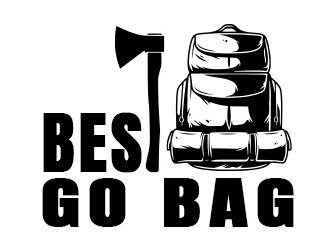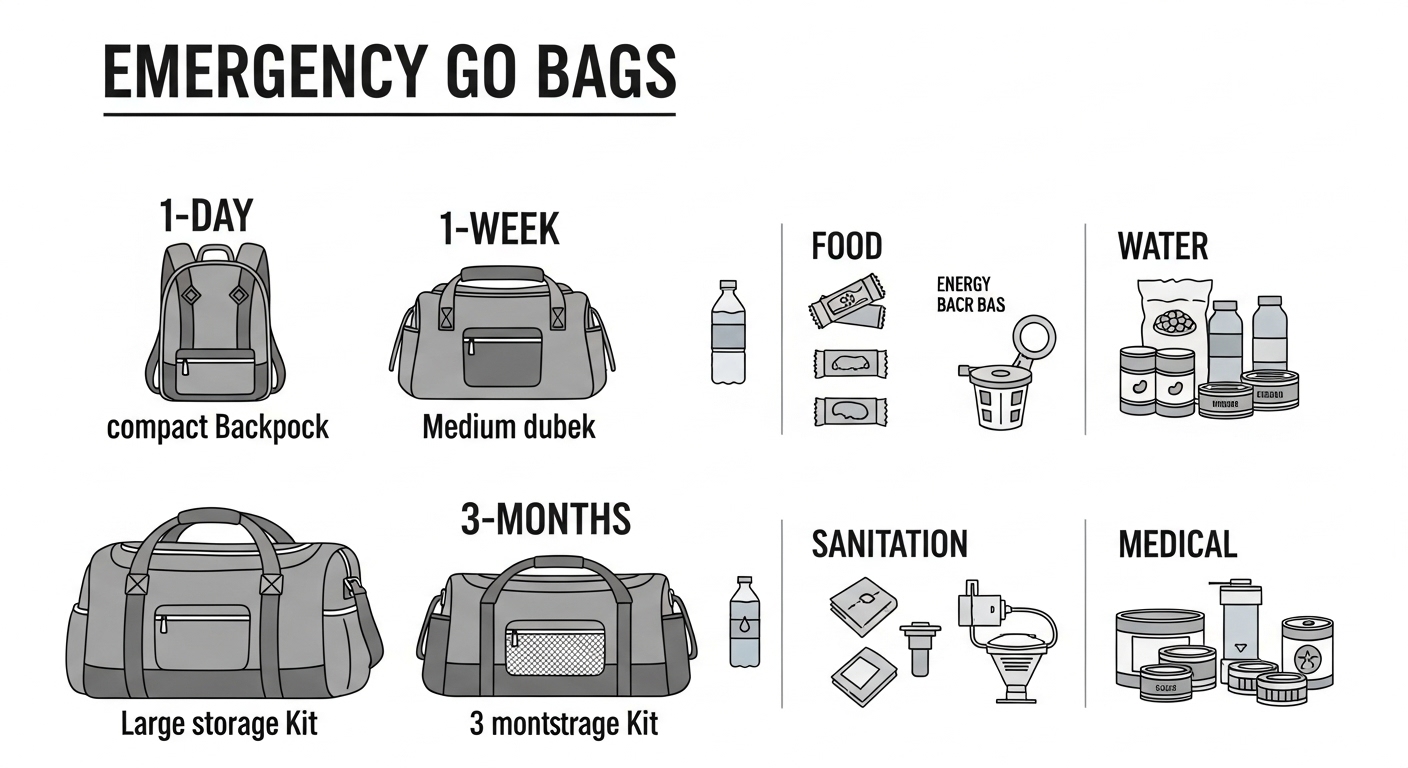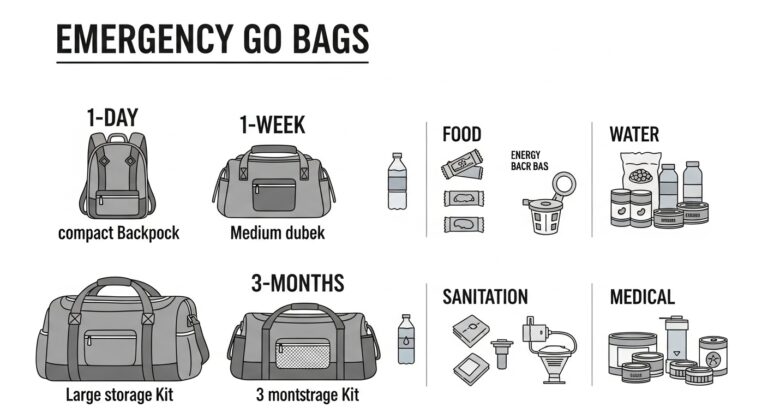When people hear the word pandemic, the mind often jumps to recent lockdowns, empty grocery shelves, and that uneasy feeling of not knowing what tomorrow will bring. But pandemics aren’t new. For centuries, humanity has been knocked off its feet by waves of disease. The Black Death in the 1300s, the Spanish Flu of 1918, and outbreaks like Ebola or SARS all taught the same lesson: those who prepare in advance survive better.
At BestGoBag.com, we specialize in survival kits designed for different timeframes. Some customers want a compact one day go bag for short disruptions. Others stock up with a three month survival bag that covers extended lockdowns or supply chain failures. Whichever path you choose, one truth is clear: waiting until disaster hits is too late.
This article looks at what history can teach us about pandemics, why survival kits matter, and how to build a kit that gives your family a fighting chance when the world outside feels uncertain.
Looking Back: Lessons From Pandemics Past
Studying history is like peeking at the test answers before the exam. The same problems keep showing up, just in different disguises.
The Black Death (1300s):
The bubonic plague swept through Europe and killed nearly half the population. Entire towns emptied out. Families locked themselves inside, not knowing if neighbors were sick. The simple act of avoiding crowds was often the only defense. The lesson here is crystal clear. Isolation and hygiene save lives.
The Spanish Flu (1918):
Arriving just as World War I was ending, this flu infected a third of the world’s people. Over 675,000 Americans died. Governments downplayed the severity, and communities were left to protect themselves. Schools and theaters closed, and masks became mandatory. The lesson? You cannot count on officials to act quickly. Personal preparedness is the first line of defense.
Smallpox:
When Spanish explorers brought smallpox to the Americas, it devastated the Aztec empire. With no immunity and no access to medical care, millions died. The lesson? Medical readiness, including vaccines or stored medications, changes outcomes dramatically.
Modern threats like SARS, H1N1, Ebola, and Zika:
These outbreaks remind us how fast diseases travel in a connected world. One infected traveler can turn local illness into global chaos within weeks. The lesson? Speed matters. The moment you hear about a spreading disease is the time to tighten up supplies and plans, not scramble later.
What Actually Happens During a Pandemic
When people think about pandemics, they often picture the disease itself. But the bigger survival challenge is the ripple effect.
- Stores empty in days. Panic buying clears shelves of food, water, and even basics like toilet paper.
- Hospitals get overwhelmed. Emergency rooms fill, and non-critical patients get turned away. Even minor problems become major if you can’t get treatment.
- Quarantines limit movement. Travel bans, closed businesses, and curfews make it hard to shop or work.
- Sanitation breaks down. More trash, less cleaning, and shortages of disinfectants make everyday living risky.
If your household had to stay indoors for two weeks, a month, or even three months, could you do it? Without outside help? That’s the real survival test.
Why Survival Kits Make the Difference
A survival go bag is not just about surviving the first 24 hours of a crisis. It is about bridging the gap between normal life and chaos. Imagine being able to say, “We’re fine, we have supplies,” while others are lining up in crowded stores during the height of an outbreak.
At BestGoBag.com, we offer survival kits that scale to your needs. The 1 day kit is light, portable, and perfect for short-term disruptions or travel. The 1 week and 1 month kits give families breathing room when stores run out. And the 3 month survival go bag is built for serious situations where leaving home is not an option.
Core Items for a Pandemic Ready Go Bag
Water and Hydration
Dehydration kills faster than hunger. During illness, fevers, vomiting, and diarrhea can quickly drain fluids. Every kit should include:
- At least one gallon of water per person per day
- Water filters or purification tablets for backup
- Oral rehydration salts or electrolyte mixes
Picture being sick at home while stores are closed. The ability to make a simple rehydration drink can literally be the line between recovery and collapse.
Food Storage
Food gives more than energy. It gives stability and peace of mind. The best pandemic foods are shelf-stable, require little prep, and provide steady calories. Good choices include:
- Rice, beans, and oats
- Freeze dried meals
- Canned vegetables and fruits
- Peanut butter and powdered milk
BestGoBag.com’s 1 month kits are carefully balanced so you don’t have to figure this out yourself. They remove the stress of guessing how much food equals real survival.
Sanitation and Hygiene
Disease spreads fastest when sanitation fails. Keep these stocked:
- Household bleach to disinfect surfaces
- Gloves, N95 masks, and goggles
- Soap and alcohol-based hand sanitizer
- Disposable wipes and paper towels
- Kitty litter for absorbing waste or spills before disinfection
- Toilet paper (essential, not optional)
It may sound unglamorous, but cleaning supplies are as critical as food. History shows the difference between survival and death often comes down to hygiene.
Medical Supplies
Pandemics overload hospitals. That means you may need to manage basic care yourself. Stock:
- Thermometers to monitor fever
- First aid kits for cuts, burns, or scrapes
- Over the counter meds like ibuprofen, acetaminophen, anti-diarrheals, nausea medicine
- Electrolyte packets for hydration
- Prescription refills if possible
- Plastic sheeting to create a quarantine room if someone gets sick
Comfort and Shelter
Staying inside for weeks is mentally hard. Adding small comforts keeps morale up:
- Flashlights and extra batteries
- Warm blankets and spare clothing
- Entertainment like books, puzzles, or playing cards
- Multi-tools for repairs
How to Use a Go Bag in Quarantine
Gear is only half the battle. How you use it matters just as much. Here are proven strategies for home quarantine:
- Set up a quarantine room. If someone shows symptoms, move them to a separate space covered in plastic sheeting with only basic furniture.
- Designate one caregiver. Fewer people exposed means lower risk.
- Use disposables. Paper plates, cups, and cutlery should be thrown away or burned after use.
- Filter the air. HEPA filters can help reduce airborne spread.
- Stay inside. It sounds simple, but avoiding exposure is the single most effective survival tool.
Seasonal and Practical Uses Beyond Pandemics
The great thing about pandemic ready go bags is that they aren’t limited to pandemics. The same supplies help in:
- Hurricanes that knock out power and water
- Blizzards that make roads impassable for weeks
- Floods that contaminate water systems
- Wildfire smoke events where masks protect lungs
- Everyday sickness when rehydration salts or masks are needed
Some customers keep a 3 day bag in the car, a 2 week bag at home, and a 3 month bag in storage. This layered approach ensures you always have something, no matter the scale of the disruption.
Common Objections to Survival Kits
People sometimes hesitate to buy go bags for a few reasons. Let’s be honest about them.
- “It takes up space.” True, but so does a refrigerator. One holds food for days, the other holds security for months.
- “The food might get boring.” Yes, but boring food beats no food. Rotate supplies and add spices for variety.
- “I’ll just shop if I need more.” Stores close quickly in crises. Relying on last-minute shopping is exactly how people end up exposed and vulnerable.
- “It feels paranoid.” Having insurance on your car isn’t paranoid. Having supplies for your family isn’t either. It’s responsibility.
Choosing the Right Kit for Your Needs
Not every family needs a massive three month supply. Start by asking:
- Do you want a compact bag for short emergencies like blackouts?
- Do you want a one month buffer to avoid panic buying during the next outbreak?
- Do you want a full three month supply so you can stay home even in the worst lockdowns?
At BestGoBag.com, we designed kits to scale with you. Many customers start small with a 1 week survival kit, then add a 3 month kit later once they realize how much peace of mind it brings.
Final Thoughts: Preparedness Brings Calm
Pandemics remind us that modern life is fragile. Grocery stores, hospitals, and jobs can all shut down with little warning. But when you know your home has water, food, medicine, and supplies, fear is replaced with calm.
That’s what a survival go bag gives you. Not hype, not panic, but peace of mind. Whether you choose a 1 day kit or a 3 month go bag, the choice to prepare is the choice to protect your family.
Preparedness isn’t paranoia. It’s responsibility. And when the next crisis hits, you’ll be glad you took that responsibility seriously.



